Home > Digitized Walters Manuscripts
This document is a tranformation of a TEI P5 XML manuscript description incorporating images. If you have trouble reading special or non-Latin characters on this page, please make sure you have appropriate Unicode fonts installed and an up-to-date web browser.
Walters Ms. W.642, Poem (masnavi)
Browse images (Browse images in a new window) | TEI in XML format
W.642
Poem (masnavi)
Vernacular: سبحة الابرار
Authority name: Jāmī, 1414-1492
As-written name: Nūr al-Dīn ʿAbd al-Raḥmān ibn Aḥmad Jāmī
Name, in vernacular: نور الدين عبد الرحمان بن احمد جامي
Note: Author dates preferred by cataloger: d. 898 AH / 1492 CE
This is an illuminated copy of the well-known poem (mas̱navī) Subḥat al-abrār (The rosary of the righteous) by Nūr al-Dīn ʿAbd al-Raḥmān ibn Aḥmad Jāmī (d. 898 AH / 1492 CE), produced in Safavid Iran. The text, written in nastaʿlīq script, was copied by Ḥaydar al-Ḥusaynī in 965 AH / 1557-8 CE, according to the Arabic colophon (fol. 112a). The manuscript opens with an illuminated double-page incipit inscribed with the title of the work and the author's name. The subsequent pages have decorated borders and gold-sprinkled margins. The dark brown goatskin binding, which is original to the manuscript, has light brown doublures decorated with filigree work on a multi-colored ground. The original shelfmark of 3934 is inscribed on the tail edge of the codex.
965 AH / 1557-8 CE
Iran
As-written name: Ḥaydar al-Ḥusaynī
Name, in vernacular: حيدر الحسيني
Book
Literary -- Poetry
The primary language in this manuscript is Persian. The secondary language of this manuscript is Arabic.
- Transliteration: katabahu al-ʿabd al-faqīr al-mudhnib al-muḥtāj ilá raḥmat Allāh /1/ wa-ghufrānih Ḥaydar al-Ḥusaynī ghaffara Allāh lahu wa-li-man qara<ʾ>ahu /2/ wa-naẓara fīhi sanat khams wa-sittīn wa-tasʿimi<ʾ>ah /3/
- Comment: Written in Arabic; gives the name of the scribe and the date of copying
Paper
cream-colored, gold-sprinkled laid paper
Foliation: 112
First folio (not a flyleaf) not counted in the foliation
Catchwords: Written obliquely on versos
15.0 cm wide by 24.5 cm high
6.0 cm wide by 12.5 cm high
- Columns: 2
- Ruled lines: 14
- Framing lines in gold, blue, orange, black, and light green
- Title: Subḥat al-abrār
- Author: Jāmī, 1414-1492
- Scribe: Ḥaydar al-Ḥusaynī
- Incipit: المنة لله كه بخون خفتم ...
- Text note: The text begins on 1b that is indicated here as 1*
- Hand note: Written in nastaʿlīq script in black with polychrome headings
- Decoration note: Double-page illuminated incipit; decorated borders and gold-sprinkled margins; polychrome section headings; framing lines in gold, blue, orange, black, and light green
Upper board outside:
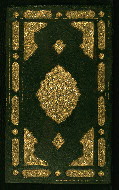
- Title: Binding
- Form: Binding
- Label: This dark brown goatskin binding with flap is a Safavid binding produced in 16th-century Iran. The central lobed medallion, pendants, and cornerpieces are brushed with gold. There is a wide border with cartouches in gold with floral motifs alternating with small quatrefoils with raised flowers.
Upper board inside:
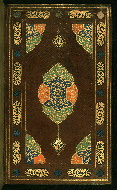
- Title: Doublure
- Form: Doublure
- Label: This light brown doublure is decorated with filigree work on a multi-colored ground of blue, orange, and green. The design consists of a central lobed medallion with pendants and cornerpieces framed by a wide border of cartouches alternating with quatrefoils.
1*:
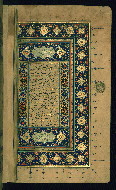
- Title: Illuminated double-page incipit with titlepiece
- Form: Incipit; titlepiece
- Label: This is the right side of an illuminated double-page incipit with the top panel inscribed with the title of the poem in white tawqīʿ/riqāʿ script on a gold background. The text area has interlinear gilt decoration with polychrome floral motifs. The illuminated borders are of a blue ground with gilt medallions and floral forms.
fol. 2a:
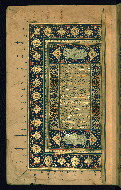
- Title: Illuminated double-page incipit
- Form: Incipit
- Label: This is the left side of an illuminated double-page incipit. The top panel is inscribed with the author's name in white tawqīʿ/riqāʿ script on a gold background. The text area has interlinear gilt decoration with polychrome floral motifs. The illuminated borders are of a blue ground with gilt medallions and floral forms.
fol. 112a:
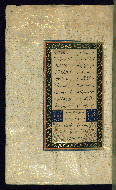
- Title: Colophon
- Form: Colophon
- Label: This colophon, written in Arabic, is dated 965 AH / 1557-8 CE and gives the name of the scribe as Ḥaydar al-Ḥusaynī. It reads as follows: katabahu al-ʿabd al-faqīr al-mudhnib al-muḥtāj ilá raḥmat Allāh /1/ wa-ghufrānih Ḥaydar al-Ḥusaynī ghaffara Allāh lahu wa-li-man qara<ʾ>ahu /2/ wa-naẓara fīhi sanat khams wa-sittīn wa-tasʿimi<ʾ>ah /3/
The binding is original.
Dark brown goatskin (with flap); central lobed medallion with pendants and cornerpieces brushed with gold; light brown doublures with filigree work on a multi-colored ground of blue, orange, and green
Seal erased; original shelfmark of 3934 on tail edge of codex
Walters Art Museum, 1931, by Henry Walters bequest
Richard, Francis. Catalogue des manuscrits persans. (Paris: Bibliothèque nationale, 1989), no. 262/1.
Principal cataloger: Gacek, Adam
Catalogers: Landau, Amy; Smith, Sita
Editor: Bockrath, Diane
Conservators: Jewell, Stephanie; Quandt, Abigail
Contributors: Barrera, Christina; Emery, Doug; Herbert, Lynley; Noel, William; Simpson, Shreve; Tabritha, Ariel; Toth, Michael B.; Valle, Chiara
The Walters Art Museum
Licensed for use under Creative Commons Attribution-NonCommercial-ShareAlike 3.0 Unported Access Rights, http://creativecommons.org/licenses/by-nc-sa/3.0/legalcode. It is requested that copies of any published articles based on the information in this data set be sent to the curator of manuscripts, The Walters Art Museum, 600 North Charles Street, Baltimore MD 21201.